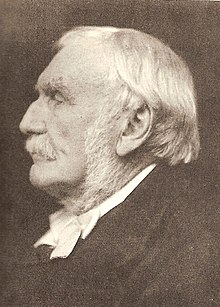Richard Strachey
Sir Richard Strachey | |
|---|---|
 Sir Richard Strachey | |
| Born | 24 July 1817 |
| Died | 12 February 1908 (aged 90) |
| Allegiance | |
| Service | |
| Rank | Lieutenant General |
| Battles / wars | First Anglo-Sikh War |
| Awards | Knight Grand Commander of the Order of the Star of India |
Lieutenant General Sir Richard Strachey GCSI FRS (24 July 1817 – 12 February 1908) was a British soldier and Indian administrator, the third son of Edward Strachey and grandson of Sir Henry Strachey, 1st Baronet.
Early life
He was born on 24 July 1817, at Sutton Court, Stowey, Somerset. From Addiscombe Military Seminary he passed into the Bengal Engineers in 1836,[1] and was employed for some years on irrigation works in the North-Western Provinces. So many members of the family were in the Indian government that sarcastic mentions were made of the "Government of the Stracheys".[2]
Life and work
Strachey served in the First Anglo-Sikh War of 1845–46, and was at the battles of Aliwal and Sobraon, was mentioned in dispatches, and received a brevet-majority.
In 1848, with J. E. Winterbottom, he entered Tibet to explore Lakes Manasarovar and Rakshastal, which his brother Henry Strachey had visited in 1846. In 1849, the two brothers briefly re-entered Tibet by following the Niti Pass out of Garhwal.[3]
From 1858 to 1865 he was chiefly employed in the public works department, either as acting or permanent secretary to the government of India, and from 1867 to 1871 he filled the post of director-general of irrigation, then specially created.
During this period the entire administration of public works was reorganised to adapt it to the increasing magnitude of the interests with which this department had to deal since its establishment by Lord Dalhousie in 1854. For this reorganisation, under which the accounts were placed on a proper footing and the forest administration greatly developed, Strachey was chiefly responsible. His work in connection with Indian finance was important. In 1867 he prepared a scheme in considerable detail for decentralising the financial administration of India, which formed the basis of the policy afterwards carried into effect by his brother Sir John Strachey under Lord Mayo and Lord Lytton.

He left India in 1871, but in 1877 he was sent there to confer with the government on the purchase of the East Indian railway, and was then selected as president of the commission of inquiry into Indian famines. In 1878 he was appointed to act for six months as financial member of the governor-general's council, when he made proposals for meeting the difficulties arising from the depreciation of the rupee, then just beginning to be serious. These proposals did not meet with the support of the secretary of state. From that time he continued to take an active part in the efforts made to bring the currencies of India and England into harmony, until in 1892 he was appointed a member of Lord Herschell's committee, which arrived at conclusions in accordance with the views put forward by him in 1878.
In 1892, Strachey attended the International Monetary Conference at Brussels as delegate for British India. He was a member of the council of the secretary of state for India from 1875 to 1889, when he resigned his seat to accept the post of chairman of the East Indian Railway Company.

Strachey's scientific labours in connection with the geology, botany and physical geography of the Himalayas were considerable. He devoted much time to meteorological research, was largely instrumental in the formation of the Indian meteorological department, and became chairman of the meteorological council of the Royal Society in 1883. From 1888 to 1890 he was president of the Royal Geographical Society. In 1897 he was awarded one of the Royal Medals of the Royal Society, of which he became a fellow in 1854; and in the same year he was created G.C.S.I. He died on 12 February 1908.
His first wife Caroline Bowles died in 1855, within a year of their marriage.
Jane, Lady Strachey (1840–1928), formerly Jane Maria Grant, whom he married on 4 January 1859, was a well-known author and supporter of women's suffrage. She co-led the Mud March of 1907 in London.
Sir Richard and Lady Strachey were the parents of thirteen children of whom ten survived to adulthood, among them the authors Lytton Strachey, James Strachey, Oliver Strachey, Dorothy Bussy née Strachey and the college head Pernel Strachey.[4]
See also
Notes
- ^ Bombay engineers according to Sabyasachi Bhattacharya (2005)
- ^ Holdich, T. H. (1908) Obituary: General Sir Richard Strachey, GCSI, FRS, LLD. The Geographical Journal, Vol. 31, No. 3 (Mar. 1908), pp. 342–344
- ^ Waller, Derek J. (2004). The Pundits: British Exploration of Tibet and Central Asia. Lexington: University Press of Kentucky. p. 13. ISBN 0-8131-9100-9.
- ^ Rita McWilliams Tullberg, ‘Strachey, (Joan) Pernel (1876–1951)’, Oxford Dictionary of National Biography, Oxford University Press, 2004 accessed 6 March 2017
Other sources
- This article incorporates text from a publication now in the public domain: Chisholm, Hugh, ed. (1911). Encyclopædia Britannica (11th ed.). Cambridge University Press.
{{cite encyclopedia}}: Missing or empty|title=(help) - Sabyasachi Bhattacharya (2005) The Financial Foundations of the British Raj. Orient Longman. ISBN 81-250-2903-6.
- Barbara Caine (2005) Bombay to Bloomsbury: A Biography of the Strachey Family. Oxford University Press. ISBN 0-19-925034-0.
External links
 Works by or about Richard Strachey at Wikisource
Works by or about Richard Strachey at Wikisource
- 1817 births
- 1908 deaths
- British Indian Army generals
- British military personnel of the First Anglo-Sikh War
- Administrators in British India
- People from Bath and North East Somerset
- British meteorologists
- Fellows of the Royal Geographical Society
- Knights Grand Commander of the Order of the Star of India
- Presidents of the Royal Geographical Society
- Royal Medal winners
- Fellows of the Royal Society
- Strachey family
- Bengal Engineers officers

